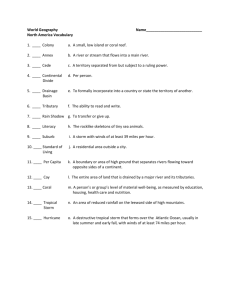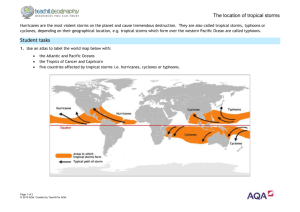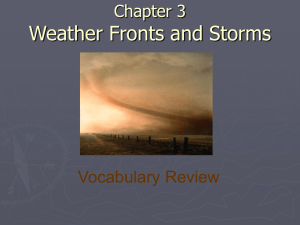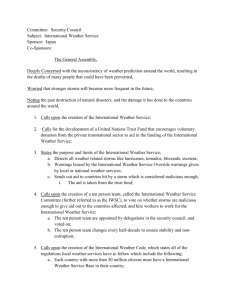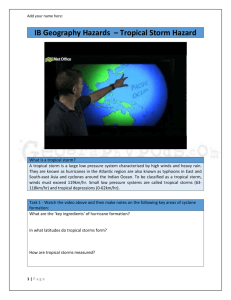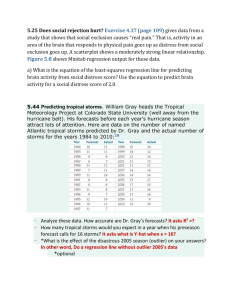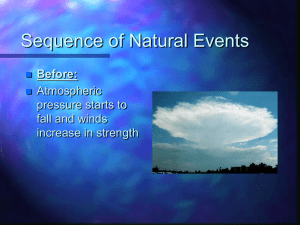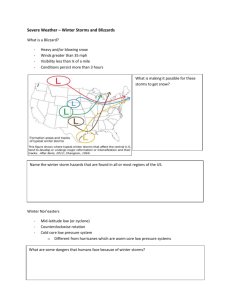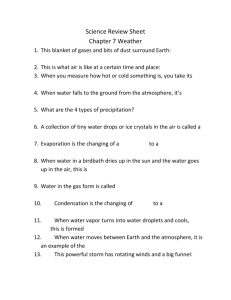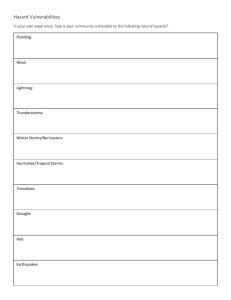Extreme Weather - Wyckoff School District
advertisement
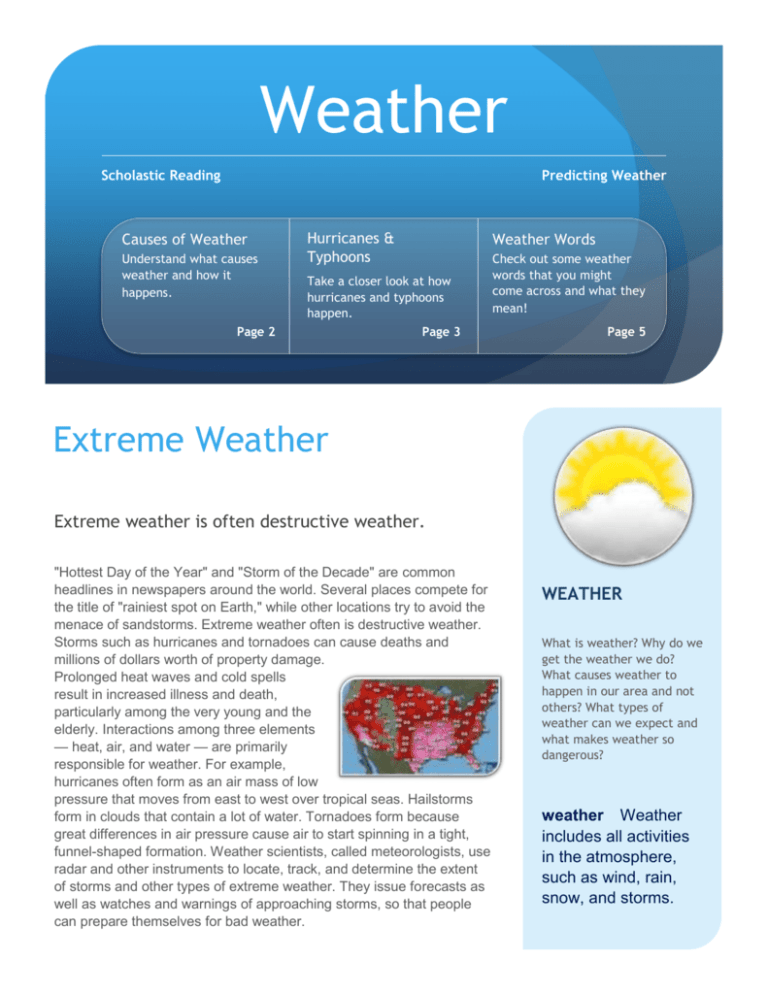
Weather Scholastic Reading Predicting Weather Causes of Weather Understand what causes weather and how it happens. Page 2 Hurricanes & Typhoons Take a closer look at how hurricanes and typhoons happen. Page 3 Weather Words Check out some weather words that you might come across and what they mean! Page 5 Extreme Weather Extreme weather is often destructive weather. "Hottest Day of the Year" and "Storm of the Decade" are common headlines in newspapers around the world. Several places compete for the title of "rainiest spot on Earth," while other locations try to avoid the menace of sandstorms. Extreme weather often is destructive weather. Storms such as hurricanes and tornadoes can cause deaths and millions of dollars worth of property damage. Prolonged heat waves and cold spells result in increased illness and death, particularly among the very young and the elderly. Interactions among three elements — heat, air, and water — are primarily responsible for weather. For example, hurricanes often form as an air mass of low pressure that moves from east to west over tropical seas. Hailstorms form in clouds that contain a lot of water. Tornadoes form because great differences in air pressure cause air to start spinning in a tight, funnel-shaped formation. Weather scientists, called meteorologists, use radar and other instruments to locate, track, and determine the extent of storms and other types of extreme weather. They issue forecasts as well as watches and warnings of approaching storms, so that people can prepare themselves for bad weather. WEATHER What is weather? Why do we get the weather we do? What causes weather to happen in our area and not others? What types of weather can we expect and what makes weather so dangerous? weather Weather includes all activities in the atmosphere, such as wind, rain, snow, and storms. We have seen lots of hurricanes recently. This is how a hurricane forms! Weather refers to the state of the atmosphere and includes temperature, precipitation, humidity, cloudiness, visibility, pressure, and winds. Weather, as opposed to climate, includes the short-term variations of the atmosphere, ranging from minutes to months. Climate is typically considered the weather that characterizes a particular region over time. The weather must be measured and records kept to gain an understanding of the forces at work and to yield the information on the averages and extremes. By studying weather records, atmospheric scientists may be able to predict the weather ahead on scales of weeks to months with greater accuracy and modify more successfully the weather to increase precipitation or ameliorate severe storms. Causes of Weather The five factors that determine the weather of any land area are: the amount of solar energy received because of latitude; the area's elevation or proximity to mountains; nearness to large bodies of water and relative temperatures of land and water; the number of such storm systems as cyclones, hurricanes, and thunderstorms resulting from airmass differences; and the distribution of air pressure over the land and nearest oceans, which produces varying wind and air mass patterns. How these five factors interact over the North American continent is an excellent example of how the weather of the United States is produced. Because the landmass of North America encompasses a greater range of latitude than longitude (10° to 80° north latitude), a great amount of differential heating occurs. This in turn creates air-mass differences. The presence of a large water area, the Gulf of Mexico, below the southern states affects the character of air masses and placement of pressure centers and storm systems over the eastern half of the continent. Warm, moist air from the south often meets cold, dry air from the north over the central United States. These contrasting air masses include: continental Arctic and polar, from cold land sources; maritime polar, from cold ocean regions; and the warmer and moist Gulf or Atlantic oceanic sources. Air from the Pacific Ocean affects the weather in the western mountains of the United States, which in turn affects the interaction of cold and warm air in the eastern United States. Continue pg 5 2 The rate of condensation heating that results from the intense rainfall associated with tropical cyclones is about 100 billion kW. Structure of the Storm The mature tropical cyclone is characterized by a circular pattern of stormclouds and torrential rains, whipped by winds that may reach velocities of 160 to 300 km/h (100 to 180 miles per hour) within a radius of 10 to 100 km (6 to 60 mi) from the storm center. The winds diminish rapidly with increasing distance. At a radius of 500 km (300 mi), wind speed is usually less than 30 km/h (18 mph). (The winds rotate in a counterclockwise direction in the Northern Hemisphere and in a clockwise direction in the Southern Hemisphere.) The heaviest precipitation occurs in this region Continued… Weather Around Us Hurricanes and typhoons are large and sometimes intensely violent storm systems. In meteorological terms, they are tropical cyclones that have maximum sustained winds of at least 120 km/h (75 mph). Atlantic and eastern Pacific storms are called hurricanes, from the West Indian huracan ("big wind"), whereas western Pacific storms are called typhoons, from the Chinese taifun, "great wind." The primary energy source for a tropical cyclone is the latent heat released when water vapor condenses. Only extremely moist air can supply the energy necessary to spawn and maintain tropical storms, and only very warm air contains enough moisture. Tropical cyclones, therefore, form only over oceans with water temperatures of at least 27° C (80° F). After they have formed, such storms tend to intensify when passing over warmer water and weaken over colder water. What are some extreme types of weather? Where might these types be found? Hurricanes & Typhoons Weather Forecasting The task of predicting the weather that will be observed at a future time is called weather forecasting. As one of the primary objectives of the science of meteorology, weather forecasting has depended critically on the scientific and technological advances in meteorology that have taken place since the latter half of the 19th century. While there are many ways we have forecasted weather in the past, today we use a barometer to forecast the weather. Making a weather forecast involves three steps: observation and analysis, extrapolation to find the future state of the atmosphere, and prediction of particular variables. One qualitative extrapolation technique is to assume that weather features will continue to move as they have been moving. In some cases the third step (prediction) simply consists of noting the results of extrapolation, but actual prediction usually involves efforts beyond this. 3 of intense convection. Thunderstorms may produce rainfall rates of 250 mm (10 in) a day. The release of latent heat associated with this rain maintains low pressure and strong winds. The total cloud system of a large tropical cyclone may have a diameter of up to about 3,200 km (2,000 mi). At the center of the storm, within a "wall" of powerful winds, there is an "eye" — a cloudfree circular region of relatively light winds that has a diameter of 10 to 100 km (6 to 60 mi). Surface pressure reaches its minimum in the eye. Typical values are 950 millibars, but values of less than 900 have been recorded. The sinking motion in the eye, which causes the clearing, also produces adiabatic warming and drying. Temperatures at 5 km (3 mi) above sea level are typically 10° C (18° F) warmer than the tropical storm's environment. The very-high-velocity winds surrounding the eye are maintained in strength by the large differences in horizontal pressure between the eye and the outer region of the storm. Although the winds themselves are responsible for much of the storm damage, the waves and tides generated by the wind often cause most of the damage to coastal areas. Because much of human activity near the coast is concentrated within a few meters above mean sea level, storm surges can result in considerable loss of life and property. Speed of Rotation The rapidly whirling tangential circulation of winds in a tropical cyclone can be explained by the conservation of angular momentum. Just as ice skaters spin faster as they bring their arms down closer to the axis of rotation, so the air rotates faster as it is pulled in toward the center of the storm by the low pressure. Without friction, the wind would increase as the inverse of the distance from the center. Thus, a wind rotating at 5 km/h (3 mph) at a radius of 500 km (300 mi.) would have a velocity of 250 km/h (160 mph) if it reached a radius of only 10 km (6 mi.). Friction reduces the predicted speed, but the basic principle explains the high rotational velocities near the center. The air that spirals toward the center and rises in the intense convection in the wall of the eye turns outward in the upper “I don’t know whether I should check the weather or let it be a surprise!” What’s the difference? troposphere (about 15 km/10 mi. above sea level). As the air moves away from the center, its counterclockwise rotation slows, in accord with conservation of angular momentum. At a distance of about 300 km (190 miles) from the center, the air acquires an anticyclonic (clockwise) rotation. Occurrence and Movement Tropical cyclones move with the large-scale wind currents in which they are embedded. The typical speed is 25 km/h (16 mph), but some storms may race along at twice this speed. Others can remain stalled in the same location for several days. This is what happened in 1998 with the powerful Hurricane Mitch, which spent time hovering off the shores of Honduras and Nicaragua. Although it eventually weakened and moved northeastward, the flooding caused by its torrential rains was particularly deadly to these two countries. The full death toll may never be certain, but many thousands of people perished in the resulting floods and mudslides. In the north Atlantic Ocean, tropical storms tend to develop primarily during the summer months of highest humidity and warmest water-surface temperatures and often appear on into October. Occasional storms develop just before or after this period but only rarely Continued… 4 Weather Words air mass A very large body of air in which weather conditions are more or less the same is called an air mass. cyclone In meteorology, a cyclone is a large system of air circulation located between the equator and either the North or South pole. The central air pressure of a cyclone is lower than that of the surrounding environment. In contrast, an anticyclone has central air pressure that is higher than that of its surroundings. hurricane Large, sometimes intensely violent tropical storm systems in the Atlantic and eastern Pacific oceans are called hurricanes. In the western Pacific, they are called typhoons. meteorology The scientific study of weather is called meteorology. precipitation Precipitation is moisture that falls from the sky, including rain, snow, and hail. in other months. Usually about five of these tropical cyclones become strong enough to be categorized as hurricanes. Typically these storms track from east to west at low latitudes, moving with the eastern winds of the large subtropical anticyclone that dominates that ocean area. As the storms approach the North American continental landmass, however, they often begin to take a more northerly tack as they curve around the western rim of the anticyclone. (Storms that do not curve in this way enter the Gulf of Mexico or cross over Central America.) As they reach higher latitudes and come under the influence of the westerlies, they usually turn toward the northeast, often missing the continent. This turn to the northeast is called recurvature. Typhoons of the western Pacific Ocean develop almost exclusively in a band between latitudes 6° and 35°, both north and south of the equator. Those in the Northern Hemisphere occur most frequently in the period from July to November. Once developed, such a typhoon generally tracks northwestwardly while it remains in the zone of the trade winds. Thereafter the storms most commonly recurve in a northeastward direction, generally picking up speed as they enter the wind zone of prevailing westerlies. Typhoons are observed most often in the general vicinity of the South China Sea, but devastating storms have also frequently occurred in the Bay of Bengal. Continued from pg 1: Weather The air movements resulting from these five weather-producing factors of North America provide an exceptional variety of weather among regions, including droughts, floods, and every known form of severe storm, including hail, ice storms, and tornadoes. These extremes alternate with calm periods of clouds or sunshine. Thunderstorms yield about half of the total precipitation in most of the United States 80 percent in drier mountain climates, 65 percent in the Great Plains, 50 percent in the Midwest, and 40 percent in the East. The weather in most places is sensitive to a few key factors. For example, severe drought in the sub-Saharan region of Africa is thought to occur when onshore winds from the Atlantic Ocean change direction by at least 60° in a relatively small area. A seasonal shift of this type is presumably related to slight differences in ocean temperatures. Such differences in turn may have resulted from changes in cloudiness related to a slight shift in hemispheric pressure patterns. tornado Also called twisters, tornadoes are storms characterized by rapidly rotating columns of air hanging from cumulonimbus clouds. weather Weather includes all activities 5 Research Weather! Now that you have idea about how weather happens and what causes weather, let’s predict some weather. Think about the time of the year, our location, and the most common types of weather we receive during this time of year in our area. What natural disaster or extreme type of weather could we expect? In our news broadcast we need to include some weather! What kind of weather could we include and what would happen if we had that type of weather coming? Look at http://teacher.scholastic.com/researchtools/researchstarters/weather/ to research a little bit more about weather. Think of a five day forecast when preparing for extreme weather. What would it look like? Extreme Weather: weather that is not normal. It can either be super hot, super cold, super rainy, super snowy, super windy. Most of the time it’s super scary! Ms. Howard’s ESL Class Eisenhower School
